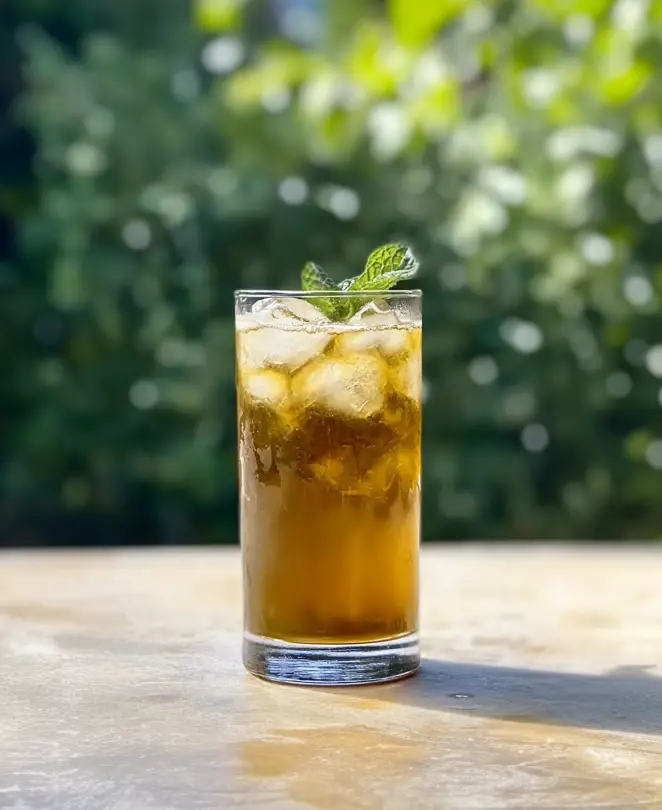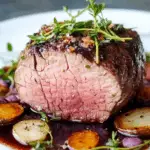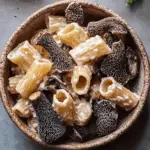Cold Brewed Yerba Mate is a refreshing South American beverage known for its earthy flavor and moderate caffeine content. Traditionally enjoyed in countries like Argentina, Brazil, and Paraguay, this cold brew method offers a smooth, less bitter alternative to hot brewing. It’s perfect for a morning pick-me-up or an afternoon refreshment.
Full Recipe:
Ingredients
- 1 tablespoon loose-leaf yerba mate or 2 tea bags
- 8 ounces (1 cup) cool water
- 1 tablespoon honey (optional)
- Pineapple, orange, or lemon juice to taste (optional)
Directions
- Combine the cool water and yerba mate in a glass or jar.
- Cover with a lid, plastic wrap, or a small saucer.
- Place in the refrigerator and let it steep overnight (approximately 12 hours).
- In the morning, strain the leaves or remove the tea bags.
- Add honey or fruit juice to taste, if desired.
- Serve and enjoy your cold brewed yerba mate.
Nutritional Facts
- Calories: 0
- Total Fat: 0g
- Saturated Fat: 0g
- Cholesterol: 0mg
- Sodium: 7mg
- Total Carbohydrate: 0g
- Dietary Fiber: 0g
- Total Sugars: 0g
- Protein: 0g
- Vitamin C: 0mg
- Calcium: 5mg
- Iron: 0mg
- Potassium: 1mg
Cultural Significance of Yerba Mate
Yerba mate holds deep cultural and social significance in South America. In countries such as Argentina and Uruguay, drinking mate is much more than just consuming a beverage—it’s a communal activity. Traditionally, mate is prepared in a hollowed-out gourd and shared among friends or family, passed around in a ritualistic fashion. This social aspect of sharing mate fosters a sense of community and connection, which is highly cherished.
The cold brewed variation of yerba mate has become increasingly popular among younger generations and outside of South America because it is more convenient and versatile, especially in warmer climates or during summer months. It provides the same energizing effects as the hot brew but with a smoother taste and without the need for specialized equipment such as a gourd or bombilla (metal straw).
Flavor Profile and Characteristics
Cold brewed yerba mate has a unique flavor that differs from the hot brewed version. While traditional hot mate can be quite strong and somewhat bitter, cold brewing softens the taste and produces a smoother, more mellow drink. The cold infusion process extracts fewer tannins, which are the compounds responsible for bitterness in many teas and herbal infusions.
The flavor can be described as earthy, grassy, and slightly smoky, with subtle vegetal notes. The cold brew also allows for easy customization—many enjoy adding natural sweeteners like honey or fresh fruit juices such as lemon, orange, or pineapple to enhance the flavor and add a refreshing twist.
Health Benefits of Yerba Mate
Yerba mate is celebrated not only for its taste but also for its impressive health benefits. It contains a combination of caffeine, antioxidants, vitamins, and minerals that contribute to its revitalizing properties. The cold brew method preserves most of these beneficial compounds, making it an excellent choice for health-conscious individuals.
-
Energy Boost: Yerba mate contains caffeine, which stimulates the central nervous system, helping to increase alertness and reduce fatigue. It provides a balanced energy lift without the jitters or crash often associated with coffee.
-
Rich in Antioxidants: Yerba mate is packed with antioxidants such as polyphenols and saponins. These compounds help neutralize harmful free radicals in the body, potentially reducing the risk of chronic diseases and supporting overall cellular health.
-
Supports Digestion: Traditionally, yerba mate has been used to aid digestion and promote gastrointestinal health. It can stimulate the production of bile and other digestive enzymes, which may improve nutrient absorption and ease digestive discomfort.
-
Boosts Immune System: The vitamins and minerals in yerba mate, including vitamins A, C, E, and several B vitamins, help strengthen the immune system and support overall wellness.
-
Enhances Mental Focus: Beyond caffeine, yerba mate contains theobromine and theophylline, natural stimulants that can improve cognitive function, concentration, and mood.
-
Weight Management: Some studies suggest that yerba mate may support weight loss by increasing metabolism, reducing appetite, and promoting fat oxidation, although more research is needed in this area.
Cold Brewing vs. Hot Brewing Yerba Mate
Cold brewing yerba mate differs significantly from the traditional hot brewing process. Hot brewed mate requires pouring near-boiling water over the leaves and steeping for a few minutes. This method extracts more caffeine and tannins, resulting in a stronger and sometimes more bitter taste. It also requires specialized equipment and is typically consumed immediately after preparation.
Cold brewing, on the other hand, involves steeping the leaves or tea bags in cold water for an extended period, usually overnight. This slower extraction process yields a less bitter, smoother flavor and often highlights the herb’s natural sweetness and vegetal notes. Additionally, cold brewed mate can be prepared in larger batches and stored in the refrigerator for several days, making it convenient for busy lifestyles.
Popular Variations and Serving Suggestions
Cold brewed yerba mate is versatile and can be enjoyed in many ways. Here are some popular variations and serving ideas to suit different tastes:
-
Sweetened Mate: Adding natural sweeteners like honey, agave syrup, or stevia can balance the herb’s natural earthiness.
-
Fruit-Infused Mate: Mixing in fresh juices or slices of citrus fruits such as lemon, lime, or orange adds a zesty and refreshing flavor dimension.
-
Herbal Blends: Combining yerba mate with other herbs like mint, lemongrass, or ginger can create unique and aromatic infusions.
-
Iced Mate Cocktails: Cold brewed mate can serve as a base for creative non-alcoholic or alcoholic cocktails, pairing well with ingredients like lime, ginger beer, or rum.
-
Sparkling Mate: Adding carbonated water to cold brewed mate creates a fizzy and refreshing drink perfect for warm days.
Environmental and Ethical Considerations
Yerba mate cultivation has traditionally been a sustainable practice, with many farmers employing eco-friendly techniques to preserve the delicate ecosystems of the subtropical forests. The plant is native to the region and grows well under the canopy of larger trees, which helps maintain biodiversity.
However, as demand grows internationally, it’s important to be mindful of sourcing yerba mate from producers who use sustainable farming practices and fair labor standards. Organic and fair-trade certified yerba mate options are increasingly available and offer consumers a responsible choice that supports both environmental conservation and social equity.
How to Choose Quality Yerba Mate
When purchasing yerba mate, consider the following to ensure you get a quality product:
-
Type of Cut: Yerba mate comes in various cuts, including “con palo” (with stems) and “sin palo” (without stems). The “con palo” version tends to have a milder flavor, while “sin palo” is more intense.
-
Freshness: Look for yerba mate that is fresh and aromatic. Avoid packages with stale or musty smells.
-
Packaging: Airtight packaging helps preserve the flavor and nutrients. Vacuum-sealed bags or tins are preferred.
-
Organic Certification: Choosing organic yerba mate ensures it is free from synthetic pesticides and herbicides.
-
Brand Reputation: Opt for reputable brands or local producers known for quality and authenticity.
Conclusion
Cold brewed yerba mate is a delightful and healthful beverage that combines rich cultural heritage with modern convenience. Its smooth, earthy flavor and natural energizing effects make it an excellent alternative to traditional coffee or tea, especially for those seeking a less bitter and more refreshing drink. The cold brew method preserves the valuable antioxidants and nutrients while offering flexibility in flavor customization.






